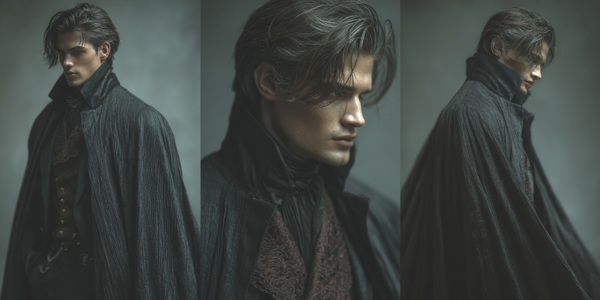
Today, we’re talking vampires. You know, those eternally stylish bloodsuckers who haunt crypts, castles, and occasionally high school cafeterias. I’ve had an obsession with vampires ever since I was a kid watching the old Hammer films starring Christopher Lee as Dracula. Then there was The Lost Boys on a too-small TV in my cousin’s basement, stuffing popcorn in my face while trying not to scream (and totally failing). And wow, have vampires changed over the years.
They’ve gone from terrifying monsters lurking in moonlit shadows to tortured romantics writing bad poetry under the stars. Somewhere along the way, they even picked up six-packs, sparkles, and teenage fan clubs. But let’s rewind and take a bite—uh, I mean look—at how they’ve evolved.
The OG Bloodsucker: Dracula and His Dramatic Cape
So, let’s kick things off with the granddaddy of them all: Count Dracula. Bram Stoker’s 1897 novel gave us the ultimate vampire blueprint. Dracula wasn’t just scary—he was extra. Tall, pale, charming in a “this guy probably owns a dungeon” kind of way, and could turn into mist, bats, or a wolf depending on the vibe.
What made Dracula terrifying was how alien he was. He represented the fear of the unknown, of foreign threats, of Victorian-era repressed everything. He wasn’t meant to be hot. He was meant to invade—your home, your body, your culture. Total nightmare fuel.
Also, let’s not forget that Stoker’s Dracula slept in boxes of dirt and had three feral brides who absolutely did not go to brunch. Not exactly romance material.
Enter: The Sexy Brooders
Fast forward a few decades, and suddenly vampires start getting hot. Like, disturbingly hot. Anne Rice’s Interview with the Vampire (1976) kicked open the door with Lestat and Louis—the drama queens of the undead world. These vampires were philosophical, tragic, sensual. They wore ruffled shirts and cried blood. Louis, bless him, was basically the emo poster boy of the 18th century.
This era of vampire lit leaned hard into moral conflict. Should I eat people? Do I deserve love? What even is humanity? You know, light dinner conversation. And this is the moment where a lot of folks started swooning over vamps instead of just hiding from them.
Bonus points for The Hunger (1983), where Catherine Deneuve and David Bowie play glamorous, bisexual vampires with an art-deco apartment and a serious goth vibe. It’s slow, it’s weird, it’s beautiful, and it’s absolutely worth watching with wine and dramatic eyeliner.
Vampires Go to High School
Then the ’90s and 2000s happened, and things got real weird.
Enter Buffy the Vampire Slayer. I was obsessed. Like, stayed-up-all-night-writing-fanfiction levels of obsessed. Buffy_gave us vampires with _layers. Spike was snarky, Angel was tortured, and everyone had amazing hair. Suddenly, vampires were metaphors for addiction, bad exes, and growing up.
And then came Twilight.
Okay, I’m just gonna say it: Twilight changed the game, whether you loved it or wanted to set it on fire. Stephenie Meyer gave us Edward Cullen—a sparkling, brooding, vegetarian vampire who moped through high school and played classical piano like it was his job. He wasn’t dangerous; he was dreamy. Like a moody Abercrombie model with fangs.
And I get it. Edward represented a fantasy: a beautiful immortal who will literally watch you sleep because he thinks you’re that special. Creepy? A little. But millions of teens were into it, and it ushered in a whole new wave of paranormal romance.
Back to the Darkness
But just when it looked like vampires had gone full YA heartthrob, the pendulum started swinging back toward the dark side.
We got gritty, violent vamps again in things like Let the Right One In, True Blood, and 30 Days of Night. These weren’t your glittering boyfriends. These were monsters. Sexy, sure, but they also ripped people’s throats out. Balance, right?
Midnight Mass (if you haven’t watched it, stop everything and go do that) took vampire lore and mixed it with religious horror in a way that made me yell at the screen. It was creepy, gut-wrenching, and thoughtful. That’s the sweet spot for me—vampires who make you feel something and maybe also ruin your sleep schedule.
Where Do We Go From Here?
Honestly? I think we’re in a golden age of vampire reinvention. You want slow-burn queer vampire romance? It’s out there. You want dystopian vampire hunters? Done. You want historical vampire drag queens who feed on corrupt politicians? Give me a minute, I’ll write it.
Vampires are basically literary shapeshifters. We reinvent them to reflect our current fears, desires, and anxieties. In the 1800s, they were foreign invaders. In the ’90s, they were brooding metaphors. In the 2000s, they were your immortal high school crush. And now? They’re everything. All at once. And I kind of love that.
So here’s to the bloodsuckers—past, present, and future. May they always be a little tragic, a little sexy, and totally unpredictable.
